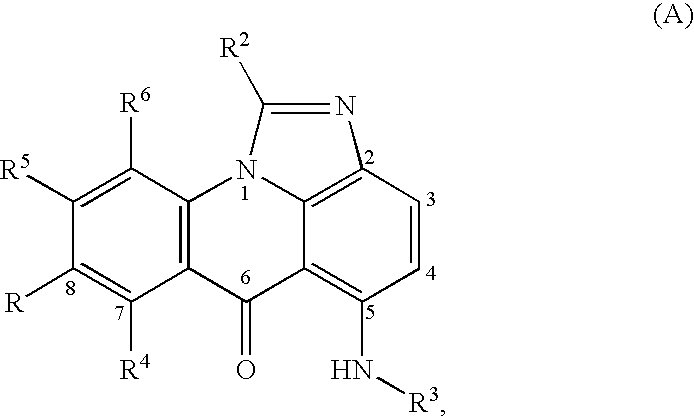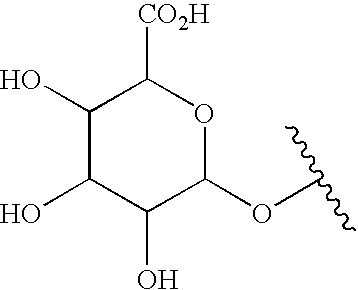Compounds for treating autoimmune and demyelinating diseases
a technology for demyelinating diseases and autoimmune diseases, applied in the field of compounds for treating autoimmune and demyelinating diseases, can solve the problems of little or no effect on fatigue and depression, loss of property, side effects, etc., and achieve the effects of promoting remyelination of nerve cells, and inhibiting lymphocyte infiltration
- Summary
- Abstract
- Description
- Claims
- Application Information
AI Technical Summary
Benefits of technology
Problems solved by technology
Method used
Image
Examples
example 1
Symadex™ Inhibits Proliferation of B-Cells Following Stimulation with LPS and T-Cells Following Stimulation with Con A in In Vitro Experiments
[0137] The activity of Symadex™ was compared to mitoxantrone in several in vitro assays to determine the effect of Symadex™ on several key regulatory systems involved in multiple sclerosis neuroinflammation and antigen presentation.
[0138] IL-4 serves as a growth and differentiation factor for B cells, mast cells and macrophages and is a switch factor for synthesis of IgE in mice. It also promotes growth of a cloned CD4+ T cell and enhances class II MHC molecule expression and resting B lymphocytes enlargement. In man, CD4+ T lymphocytes also produce IL-4, but the human variety has not been shown to serve as a B cell or mast cell growth factor. Both murine and human IL-4 induce switching of B lymphocytes to synthesize IgE. Human IL-4 also induces CD23 expression by B lymphocytes and macrophages in man. IL-4 may have some role in cell mediated...
example 2
Symadex™ Alleviates the Symptoms of Experimental Autoimmune Encephalomyelitis (EAE), an Animal Model of Chronic Multiple Sclerosis in a Weekly Treatment Cycle for 4 Weeks
[0146] One method of showing the utility of the a pharmaceutical compound for the treatment of various conditions associated with multiple sclerosis (MS) is its ability to inhibit effects of Experimental Autoimmune Encephalomyelitis in laboratory animals.
[0147] Experimental Autoimmune Encephalomyelitis (EAE) is an animal model for MS, which entails inducing a T-cell-mediated autoimmune disease against myelin basic protein in certain susceptible mammalian species. The EAE model is an appropriate method for studying the inflammation of the brain and spinal cord associated with MS (see Bolton, C. Mult, Scler, 1995; 1(3); 143-9).
[0148] In rodents, injection of whole spinal cord or spinal cord components such as myelin basic protein induces an autoimmune response based on the activation of T-lymphocytes. Clinical dise...
example 3
Symadex™ Alleviates the Symptoms of Experimental Autoimmune Encephalomyelitis (EAE), an Animal Model of Chronic Multiple Sclerosis in a Weekly Treatment Cycle for 4, 6, 8 and in a 4 Week on Drug-4 Week Off Treatment Cycle
[0159] The experiment described in Example 2 was extended to a larger cohort and longer treatment cycle with several objectives in mind. In addition to corroborating the initial findings, a concerted effort was directed at also demonstrating the extent and durability of response, including the effect after drug withdrawal, and to document the impact of drug treatment on immune function in order to uncover any signals of impending impairment or toxicity.
[0160] Following disease induction, as previously described, the animals were randomized into 5 five cohorts, one vehicle control and 4 treatment cohorts. Animals in the treatment cohorts were administered study drug intraperitoneally at 20 mg / kg (Symadex™dihydrochloride trihydrate) once a week for 4, 6 and 8 weeks,...
PUM
| Property | Measurement | Unit |
|---|---|---|
| Weight | aaaaa | aaaaa |
| Time | aaaaa | aaaaa |
| Density | aaaaa | aaaaa |
Abstract
Description
Claims
Application Information
 Login to View More
Login to View More - R&D
- Intellectual Property
- Life Sciences
- Materials
- Tech Scout
- Unparalleled Data Quality
- Higher Quality Content
- 60% Fewer Hallucinations
Browse by: Latest US Patents, China's latest patents, Technical Efficacy Thesaurus, Application Domain, Technology Topic, Popular Technical Reports.
© 2025 PatSnap. All rights reserved.Legal|Privacy policy|Modern Slavery Act Transparency Statement|Sitemap|About US| Contact US: help@patsnap.com



